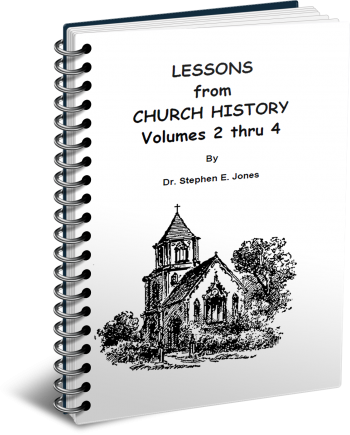Latest Posts
View the latest posts in an easy-to-read list format, with filtering options.

Volumes 2-4. This is the history of the Church from the Roman War (66-73 A.D.) to Constantine and the Council of Nicea in 325 A.D. with lessons to be learned from it.
Category - History and Prophecy

Diocletian had divided the Empire as early as 285, shortly after becoming Emperor. He ruled from Nicomedia in Asia Minor; Maximian from Milan in Italy. Each one deputized a Caesar, who in theory was an equal, but in practice a subordinate.
Maximian deputized Constantius, who ruled the Northwest portion of the empire from Trier, his capital city in Gaul. In order to consolidate his position with Maximian, Constantius divorced his wife Helena to marry Maximian's youngest daughter, Theodora.
Diocletian's caesar was Galerius, who consolidated his position by marrying Diocletian's daughter, Valeria. She came to be known as Galeria Valeria (of course!).
Galerius ruled Armenia and the easternmost part of the empire. Galerius was the one most responsible for pushing Diocletian into persecuting the Christians in 303. Many historians believe that Galerius was the one who set the fires in Diocletian's palace in Nicomedia in order to blame the Christians and motivate Diocletian to persecute the Church.
Diocletian seems to have gone mad in 305 and retired. He then told Maximian, his counterpart from Milan, to retire also. Then Constantius, the father of Constantine, died in 306 at York in Britain. This would have left Galerius as sole emperor, but young Constantine was elevated by his troops to replace his father as Augustus of the Western Empire.
But Maximian also came out of retirement, disavowed his forced abdication, and reasserted his claim as co-emperor of the West with his son, Maxentius. This put them in direct conflict with Constantine. Maximian soon became fearful and came to Trier to make peace with Constantine. The peace was secured when Maximian's daughter, Fausta, was given in marriage to Constantine.
The first edict granting toleration to at least a limited portion of the Roman Empire was issued in 306. It was done by Constantine on behalf of Spain, Gaul, and Britain, and also by Maxentius on behalf of Italy and North Africa. This toleration put an end to the persecutions in the West.
But when Maximian's son, Maxentius, saw himself losing power, he staked his own claim as emperor of the West. His father, Maximian, found himself squeezed between a rock and a hard place, but had little choice but to back Maxentius. This put Maxentius and Constantine in conflict, and their armies met in 310. Maximian was then killed, while his son Maxentius lived to fight again until 312, when he was thrown off the Milvian Bridge and drowned.
The Emperor of the East was Licinius, who met Constantine at Milan in 311. They issued a JOINT Edict of Toleration at that time to bring to the East (the Balkans) what had already been established in the West.
In 312 Constantine marched into Italy to meet the army of Maxentius at the famous Battle of the Milvian Bridge. Constantine's British and Gallic army was largely demoralized from being so far from home and was in need of a morale booster. Just before the battle, Constantine told the troops of a wonderful vision that he had received of a cross in the sky above the words, In Hoc Signo Vinces, “In This Sign, Conquer.”
Putting the sign of the cross on their armor, they won the battle, and Constantine pushed Maxentius off the bridge into the Tiber River, where he drowned. This put Constantine as sole Emperor of the Western half of the Roman Empire. Licinius ruled the East until 324, when Constantine united the entire Roman Empire back under a single ruler after nearly 40 years of division.
Meanwhile, in 313, Constantine and Licinius issued a joint letter to be circulated among the governors of the East, declaring religious toleration to all. This was known as the Edict of Milan. It officially made Christianity a legalized religion and removed from the Church the requirement to sacrifice to pagan gods or to Caesar. This letter was sent especially to Anatolia and Oriens, the territory farthest east that had been under the rule of Maximian.
Thus, religious toleration was actually a process that took a full seven years to complete (306-313). I find this significant, because 306 was 40 rest-years after the 80th Jubilee from Adam (26 A.D.).
The year 313 was 40 rest-years after Jesus' crucifixion in 33 A.D. The seven years from 26-33 A.D. was Daniel's 70th week, as I showed in my book, Secrets of Time.
I have often stated that the pattern of King Saul's 40-year reign was a pattern for the 40-Jubilee “reign” of the Church under Pentecost. But there is more to it than that. There was a pattern of 40 YEARS, 40 REST-YEARS, and 40 JUBILEES.
The 40-YEAR pattern started from 26-33 A.D., and ended from 66-73 A.D. This was the time of the Jewish Revolt, which saw the destruction of Jerusalem. It ended with the taking of Masada at Passover of 73.
The 40-REST-YEAR pattern had the same starting dates (26-33), and ended from 306-313 A.D.
The 40 JUBILEE pattern again had the same starting dates (26-33), and ended from 1986-1993. These are explained in greater detail in my book, Secrets of Time.
So we see how the story of Constantine plays a large factor in the second of these major Church cycles and is thus important to gain a comprehensive understanding of Church history. Seeing the three “40's” puts Constantine into the context of a much bigger prophetic history of the Pentecostal Age. The Age of Pentecost, in turn, has to be understood in its own context, for there were three major prophetic feast days to consider: Passover, Pentecost, and Tabernacles.
The Passover Age was from Moses to Christ, beginning with that first Passover when Israel came out of Egypt. It ended at that great Passover when Jesus was crucified.
The Pentecostal Age began with the fulfillment of Pentecost in Acts 2, and began to end in 1993 after 40 Jubilees. Even so, as I have written in the past, there was also a 7 and a half year transition from 1993-2000, correlating to the story of King Saul and his son, Ish-bosheth. The point is that we are now entering into a Tabernacles Age in long-term prophetic history. Our understanding of the times we live in today will rise or fall upon our knowledge and understanding of the long-term prophetic history of the Bible and the Divine Plan.